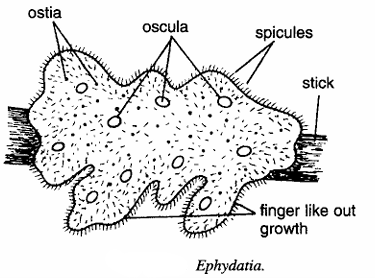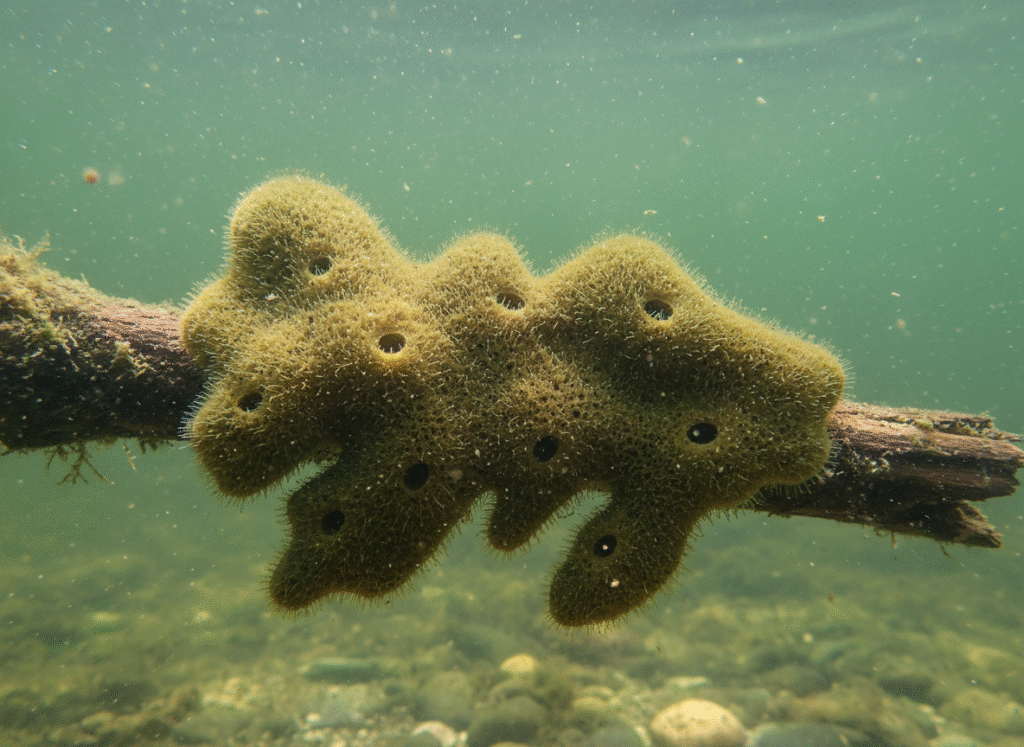Classification of Ephydatia
- Phylum: Porifera (Pore-bearing animals with cellular organization and asymmetrical or radial body forms)
- Class: Demospongiae (Sponges with skeletons made of spongin fibers and siliceous spicules)
- Order: Spongillida (Freshwater sponges adapted to continental water bodies)
- Family: Spongillidae (Sponges with gemmules for dormancy and survival during adverse conditions)
- Genus: Ephydatia
Ephydatia is a genus of freshwater sponges found across diverse aquatic habitats worldwide. Known for their ecological significance in freshwater ecosystems, these sponges exhibit unique adaptations that enable survival in various environmental conditions.

Habit and Habitat
Ephydatia species inhabit freshwater environments, including lakes, ponds, rivers, and sometimes brackish water areas with low salinity. They attach themselves to submerged surfaces such as stones, wood, and aquatic plants. These sponges thrive in lentic (still water) and lotic (flowing water) habitats under varying climatic zones.
Geographical Distribution
Ephydatia has a cosmopolitan distribution, with species recorded across the Northern and Southern Hemispheres. Common species like Ephydatia fluviatilis have been noted in Europe, Asia, and the Americas. The genus adapts well to diverse climatic conditions, from temperate to tropical freshwater ecosystems.
General Characteristics
- Body of the animal consists of delicate chimney like tubes or finger like outgrowths.
- At the end of each chimney lies an osculum.
- Surface is perforated by several large oscula and large number of pores or ostia. Scattered monaxon spicules are protective. Amphidisk spicules present.
- Food consists of organic particles, unicellular plants and infusorians.
- Species growing in bright light acquire a greenish colour due to intracellular symbiotic Zoochlorellae.
- McNair found that stimuli applied at the oscular rim would be transmitted down the chimney, resulting in contraction or collapse of the latter.
- It shows sensory nature of the osculum.
- Asexual reproduction by gemmules.
- Bodies range from encrusting sheets to irregular or lobed masses, sometimes cushioned.
- Typically greenish to brownish in coloration due to symbiotic algae.
- The outer surface may be rough or hispid, attributed to emerging spicules.
- Oscula and ostia are well developed for water flow and filtration.
- Skeleton mainly includes slender smooth or spiny oxeas and distinctive birotule gemmuloscleres.
- Capable of forming gemmules, small resistant buds that survive adverse periods such as freezing or drying.
- Reproduction occurs through both sexual and asexual modes, aided by gemmulation for overwintering.

Special Features
A key adaptation of Ephydatia is the ability to produce gemmules, enabling survival through unfavorable environmental stresses. The genus also showcases remarkable phenotypic plasticity, with some species able to tolerate varying salinity and temperature regimes. Their symbiotic relationship with bacteria and algae enhances their resilience and nutrient intake.
Identification
Ephydatia is recognized by its soft-bodied, often greenish to brownish sponge morphology with rough or hispid surface. Microscopically, the presence of birotule gemmuloscleres with distinctive rotules and smooth or spiny shafts is diagnostic. Field identification can be assisted by observing gemmule presence during dormancy.
References:
- https://en.wikipedia.org/wiki/Ephydatia
- https://en.wikipedia.org/wiki/Ephydatia_fluviatilis
- https://pmc.ncbi.nlm.nih.gov/articles/PMC5445566/
- https://animaldiversity.org/accounts/Ephydatia/classification/
- https://www.entomoljournal.com/archives/2020/vol8issue5/PartA/8-4-298-789.pdf
- https://www.epa.ie/publications/research/biodiversity/Classification-of-freshwater-sponges.pdf
- https://www.sciencedirect.com/science/article/abs/pii/S0380133019301984
- https://www.vedantu.com/animal/freshwater-sponge
